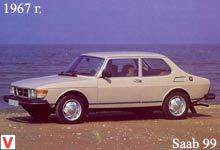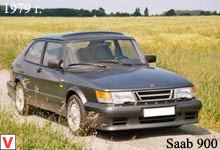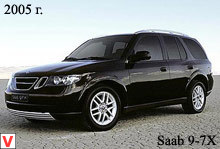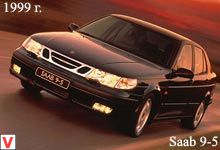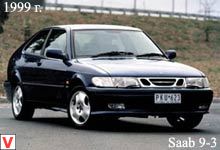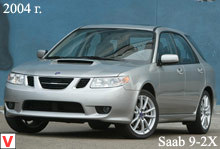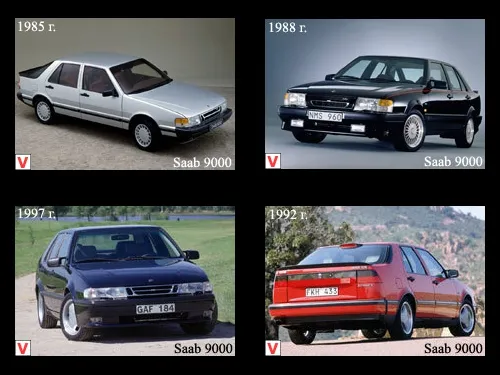
In 1974, the Swedes faced the issue of producing their own business class model. True, it turned out that Saab-Scania does not have the funds or experience to carry out such a project. At the turn of the eighties, the Swedish company entered into an agreement with Fiat Auto to jointly develop a model designed to become the flagship in the production programs of both parties. The project received the code name Tipo 4. And in May 1984, the first Saab 9000 came off the assembly line.
Then the car was equipped with a single engine - a two-liter turbo engine with four valves per cylinder, borrowed from the 900 Turbo 16S. Unlike the old Saab, the engine on the 9000th is located transversely and tilted slightly forward. Since 1987, the 4-speed German “automatic” ZF was installed. Front suspension Saab 9000 - McPherson with one lever.

The rear suspension is a very durable beam on double trailing arms and Panhard thrust. In contrast to the classic Saab 70-80-ies at the 9000th parking brake captures the rear, not the front wheels. After 1987, ABS became the standard equipment for the Saab 9000. In January 1988, a sedan appeared. To distinguish the body, sedans began to call the 9000 CD (hatchbacks are indices 9000i / 9000 T16, etc.). The model design was developed in Italy, in the studio Italdesign Giugiaro.
And all because "nine thousand" is built on the same platform with FIAT Croma, Alfa Romeo 164, Lancia Thema. Saab brings Italian relatives to the structure of the suspension and the architecture of the body. And the doorways, glass frames and some other details of the Fiat, Lancia and Saab are the same.
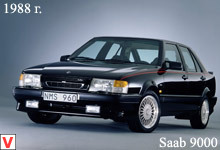
Sedans were originally produced with inclined headlights and grille, while the hatchback until 1990 "front" stood upright, later - like a sedan. In 1991 (1992 model) Saab 9000 hatchback was subjected to the second, this time a deeper restyling, completely changed the plastic of the nose and tail. The updated version with the new B204 engines and the so-called “narrow face” is called the 9000 CS (the old version with the B202 engine and the “wide face” was produced until 1993 under the 9000 CC index). Until 1993, there were two parallel ignition systems.
The usual Bosch LH-Jetronic with distributor (distributor) and the so-called “direct system” (Direct Ignition) - with separate ignition coils for each cylinder. In the DI system, the ignition is controlled by a computer, there are no high-voltage wires and a distributor, a single cartridge (cassette) with coils is attached to the cylinder head. In 1994, modernized and sedan. Constructively upgraded versions are not much different from previous ones. The main differences are in the design: narrow headlights, a thin grille, a more sloping hood and a protruding trunk lid. After restyling, the system of modifications was finally formed.
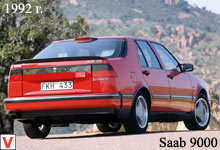
Depending on the configuration hatchbacks are called CS, CSE and Aero, and sedans - CD, CDE and Griffin. Note, Aero is a hatchback privilege. The Aero versions (9000 T16S Aero / 200 hp until 1992 and 9000 Aero / 225 hp from 1993) are different from ordinary bumpers without an accordion, spoilers in a circle, with three-spoke alloy wheels, more rigid springs, and in the cabin - seats with improved lateral support, leather steering wheel and door inserts. It also installs a 3-liter V6 engine (since 1996). This is a technically advanced engine designed for those who are able to appreciate the soft power that only a six-cylinder engine can provide.
12 inlet valves receive the working mixture through several channels resonating at different frequencies. The result is excellent traction in a wide range of engine revolutions. 90% of the torque (270 Nm) is achieved starting at 2400 rpm. Salon Saab is very comfortable.
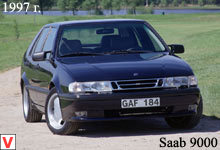
Spacious, with good quality finishes. Inside there is enough space for five adults who can travel with first-class comfort. A lot of free space for movement in all places and all sorts of pleasant things, such as illuminated front seat belt buckles. The large, wide opening door provides excellent access to the luggage compartment, which can be easily increased due to the folding backrest in a 60/40 ratio. The trunk in the hatchback is 625-1600 liters (after restyling - 490-1400 liters), and in the sedan - 555 liters. The back of the rear seat folds apart only in hatchbacks: in sedans there is only a hatch for long loads.
Saab 9000 is one of the safest cars in the world. Not only when it comes to the ability of the car to help the driver avoid an accident, but also its ability to reduce the impact of the impact force on passengers.
